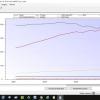True, however I didn't buy it based on future performance possibilities.

Supercharged Intake Temps
#121

Posted 22 June 2014 - 12:16 PM
#122

Posted 22 June 2014 - 04:13 PM
that's a turbo car, completely different set of issues.
air mass for a turbo is temp and pressure related *AFTER* the turbo, unlike with a (positive displacement) supercharger.
please try and understand what actually happens here, and stop mixing up different issues from different engine setup's.
with a SC install, unless you get to the point of having to pull timing to prevent det, a change in IAT after the intercooler makes zero odds to power, the only caveat to this is that with higher temps, the boost goes up so the parasitics will also rise a little, however, on a dyno it's almost impossible to actually see/measure this (and yes, I have tried a few times).
on a turbo, this is not true, as boost is actively controlled, so if the temps go up, the air becomes less dense, and as boost control will limit the absolute boost, you will have less air mass for a given boost, ie, less air = less power.
Understand the part of the SC being a constant volume air pump. So at constant ambient air temperature, it's the rpm of the SC that determines the volume of air and hence the mass of air the SC is pumping. In the above I assume that you mean a change in temperature after the SC and not after the intercooler, with the reasoning being that when you cool the charge, the pressure (boost) goes down as essentially you can't change the air mass. So when you cool, the engine gets cooler air, but not more air mass. And you want air mass.
But why bother putting the laminovas in than? Is that 'just' to prevent detonation?
#123

Posted 22 June 2014 - 05:45 PM
Understand the part of the SC being a constant volume air pump. So at constant ambient air temperature, it's the rpm of the SC that determines the volume of air and hence the mass of air the SC is pumping. In the above I assume that you mean a change in temperature after the SC and not after the intercooler, with the reasoning being that when you cool the charge, the pressure (boost) goes down as essentially you can't change the air mass. So when you cool, the engine gets cooler air, but not more air mass. And you want air mass.
But why bother putting the laminovas in than? Is that 'just' to prevent detonation?
I think you're massively underestimating just what the laminova is doing for you.
Not got figures for the VX, but on a K20 running an M62, I have seen air temps at the SC exit of well over 160C, with no cooling, you would simply be straight into det at any significant boost level.
you guys with TVS's are running them at a PR of over 2.2, at which point they are (at best) some 65% efficient, I'm guessing the port exit temps are probably in the 150-170C bracket
your laminova's are pulling some 80-100C out of that, and to put it bluntly, that's pretty impressive for such a small package.
#124

Posted 22 June 2014 - 05:45 PM
#125

Posted 22 June 2014 - 07:24 PM
So is it the fuel which is being used to cool the air?Throwing fuel in is always a good way of loosing power...
#126

Posted 22 June 2014 - 07:30 PM
Throwing fuel in is always a good way of loosing power...So is it the fuel which is being used to cool the air?[/quote] Not really, just most calibrations use throw fuel at it as a last resort. Its harder for a stupidly rich charge to det than a more normal one.
#127

Posted 22 June 2014 - 10:21 PM
yup...
other point worth making is that if the engines happy running at X boost and Y IAT's, then reducing the AIT's further whilst a laudable goal, does not actually gain you anything (unless you're going to speed up the SC or add more advance)
by reducing the AIT's, you should actually see a reduction in boost, as the air mass you are dealing with will not change (that's a function of the SC drive ratio and air intake temps to it minus a bit of air leakage around the rotors).
not suggesting 90C is good, but are you actually having to pull timing off to keep out of det at this point and thus losing some potential HP?
and before you rush off and install water injection, just consider for a moment what effect this will have on your laminova cores... (assuming you're planning on using it at the SC inlet?)
Lastly, saw a comment about the crank vent earlier, in a SC car the very last thing you want is to recirc crank venting into the engine, oil vapour has a terrible octane rating and will effectively de-octane your fuel charge significantly, seem a lot of engines pushed into det because of this.
catch tank and filter away from the intake is the go..
Never thought about the influence of oil (pcv) vapours on detonation, but this is one very good reason to block the PCV path in the head/intake mani...
And regarding the airpath during low loads (bypass open and air recirculatesthrough SC under vacuum conditions); the actual air mass going into the engine is indeed not much and will be pretty hot, but also the Laminova's have then little airmass to cool down to reasonable temps... We never have observed this spiking of the IAT's with closed throttle. (LSJ ecu) Just the gradual increase of temps during hard use on track.
#128

Posted 22 June 2014 - 10:28 PM
#129

Posted 22 June 2014 - 10:32 PM
Is this, again, due to poor attention to detail in calibration (oops, remapping) where the wot powaaaaahhhhhhhh bit is checked and 75% ok so its all good to go but they forget the actual part of the cal that will be used 99% of the time....
What is due to poor calibration?
(WOT power is indeed the easy bit. Spend serious time on the low load and transition behaviour, not to mention you need correct dynamic injector offset values to get this right... ![]() )
)
#130

Posted 22 June 2014 - 10:39 PM
#131

Posted 23 June 2014 - 08:20 AM
Is this on Tmap sensor Or map sensor ?Retarding ignition from 57 is an oem feature, not an obd tuner feature. (i had the same loss of power feeling on my CS basemap on a hot day) On last years LOT day at Zandvoort Peter did change the 57 to a higher value on one of the suffering speedsters and the owner complained about performance loss. After checking with Peter later, he mentioned he leaves it to default 57 by default to protect the engine.
He was on tmap when this happened.
Peter put him on 80 degrees and his car was responding as he was used to.
#132

Posted 23 June 2014 - 09:00 AM
#133

Posted 23 June 2014 - 09:14 AM
#134

Posted 23 June 2014 - 09:14 AM
No, you need to ask Peter
#135

Posted 23 June 2014 - 09:17 AM
#136

Posted 23 June 2014 - 09:17 AM
No, you need to ask Peter
I emailed him, but no response yet.
#137

Posted 23 June 2014 - 09:19 AM
Is this, again, due to poor attention to detail in calibration (oops, remapping) where the wot powaaaaahhhhhhhh bit is checked and 75% ok so its all good to go but they forget the actual part of the cal that will be used 99% of the time....
What is due to poor calibration?
(WOT power is indeed the easy bit. Spend serious time on the low load and transition behaviour, not to mention you need correct dynamic injector offset values to get this right...
)
amen to that!
doing WOT dyno stuff is easy, doing the rest of the map is not a five minute job, OEM's spend thousands of hours in all kinds of countries to get this sh*t right, so the idea you can do the same in half a days pissing about is laughable.
getting back to the subject, people seem to be getting their wires crossed here, the limitations of the ECU and whatever temp sensor you're using are nothing to do with the basic operation of the intercooler.
having played with the dutch software, I can't tell from what the user is given to work with, what it's actually doing, thus for me, as a calibration tool, it's almost zero use.
Peter (is that right?) either needs to put out there *all* the functions/tables/controls for this to be a usable calibration tool, yes, that will make it harder for the typical owner/driver to understand/use, BUT IMHO if you don't understand all that's involved in engine calibration, you should not really be doing the job, stick to using it as a map loading tool.
As I sit here, I have no idea just how much control Peter has over the ECU, all I know is that the open bits so far are probably less than 5% of what controls/tables/etc that are required.
besides all that, it also needs a proper dyno tools page(s) with real time controls/displays of *all* the relevant tables/corrections/parameters.
#138

Posted 23 June 2014 - 10:06 AM
What's the alternative? If you want to SC the 2.2, you have a choice between Peter's OBDTuner, going to some tuner to get it mapped or running a standalone ECU. For me that choice was easy, as OBDTuner at least gives you some control. Going to some tuner and getting it mapped was not an alternative for me. You completely depend on someone else and the results don't seem to be optimal. Sure, these people have experience and know what they do, but as you mention, to get it right within the limits set by simple economics is not a trivial task. Going the standalone ECU route would mean I'm on my own. No idea where to go for a base map, some support etc. Running OBDTuner with the SC, frankly I'm surprised about how good it is.
#139

Posted 23 June 2014 - 10:13 AM
Edited by CHILL Gone DUTCH, 23 June 2014 - 10:16 AM.
#140

Posted 23 June 2014 - 10:41 AM
full stand alone is only a few quid more depending which you go for, and could be calibrated faster (Ie less dicking about) thus costing less in terms of man time.... also the standalone is sellable afterwards to anyone else and tends to only lose 20% MAX value.
1 user(s) are reading this topic
0 members, 1 guests, 0 anonymous users















